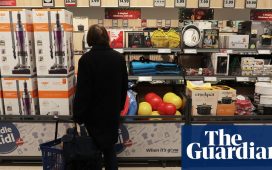As a privately owned company, Aldi rarely gets the sort of scrutiny faced by its listed competitors Coles and Woolworths, which are required to provide regular public disclosures including profit updates.
But a government-ordered inquiry into the supermarket sector has provided some interesting insight into Aldi’s profits and strategy as its executives endure hours-long questioning by the consumer watchdog.
Here are three things we learned on Monday at the Australian Competition and Consumer Commission hearing.
-
1. Aldi makes a lot of money
Aldi generates about $12bn of annual revenue from its Australian operations, according to testimony at the hearing.
While Aldi executives reminded the inquiry that its finances are confidential, the company’s managing director of national buying, Jordan Lack, acknowledged that the $12bn figure was a fair approximation when asked directly by the ACCC’s counsel, Naomi Sharp SC.
The figure was provided to the ACCC by Woolworths in its submission to the inquiry.
Aldi does disclose some of its financials in regulatory filings as well as tax data via the Australian Taxation Office, but it is rare for it to disclose an updated revenue figure.
While revenues don’t take into account costs, the figure still suggests the Australian market, where it now has about 600 stores, is a very profitable one for the discount German retailer.
It has carved out a 10% niche in a groceries sector dominated by its more expensive rivals, Coles and Woolworths, which collectively control two-thirds of the market.
-
2. ‘Middle aisle’ is a money maker
Aldi’s famed middle aisle, where shoppers can buy everything from a bike seat to a lemon tree, doesn’t just create a point of difference from its rivals; it’s also very profitable.
The Aldi executive Oliver Bongardt told the hearing that its “receiving margins” for middle aisle items, also known as special buys, is higher than what it generates from other products.
This may surprise some shoppers who assume it’s hard to make money by selling air fryers at $59.99.
The “receiving margin” reflects the difference between the price that Aldi pays the supplier and the price charged to shoppers.
That margin doesn’t, however, take into account any markdowns or unsold items, which means the profitability of middle aisle items is dependent on how many people buy their air fryers from Aldi.
While Aldi publishes the price of items in its catalogue online, consumer advocates want it to display the cost of all its groceries to help shoppers conduct price comparisons with Coles and Woolworths before deciding where to shop.
Aldi executives told the hearing there was currently a “technical limitation” in doing so, but it would aim for all prices to be published online “within the next year”.
Aldi Australia executives Jordan Lack, Oliver Bongardt and Andrew Starr at Monday’s hearing. Photograph: ACCC live stream/AAP -
Some of Aldi’s cost-saving practices are self-evident, such as minimal shop floor staffing and its insistence that shoppers pack their own bags.
Aldi generally has much smaller stores than Coles and Woolworths, with far fewer products, which reduces property and product handling costs. It also heavily relies on selling its own brands.
This all helps Aldi charge cheaper prices than Coles and Woolworths, with Choice finding that an Aldi grocery bill is typically about 25% cheaper than an equivalent basket of items at the major chains.
However, Aldi is facing challenges that may halt the growth of its market share.
While Coles and Woolworths are expanding their online shopping portals to tap into a change in consumer behaviour, Aldi is sticking to in-store-only sales.
“We did an assessment of online and understand that channel to be a costly channel to serve,” Lack told the hearing.
“That comes down to the fact that if you have employees picking the groceries instead of customers doing their own shopping, obviously that is a cost that is incurred.”
Aldi representatives also told the hearing it could not operate in all of the locations its rivals do, such as Tasmania and the Northern Territory, because of the “cost to serve those markets”.
“We look at the catchment on the size of the market and what would be required to set up operation, and we made the decision not to enter those markets on that basis,” Lack said.
The ACCC is conducting a series of public hearings this month involving executives of all of the major supermarkets as part of its examination into grocery prices and competition in the sector.
The regulator is scheduled to provide its final report to the government by the end of February.
after newsletter promotion
Separately, the ACCC is suing Coles and Woolworths over allegations they deceived customers with fake discounts.









